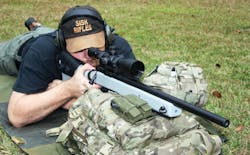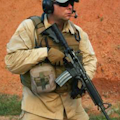When it comes time to purchase precision long guns for their marksmen, most agencies will go shopping for off-the-shelf, bolt-action rifles. After the rifles arrive the troops will go about trying to adapt them to the individual shooters. They’ll add cheek pads and spacers, either from the store or home-made. I’ve seen some interesting cheek pads made from foam and duct tape. Buying an off-the-shelf rifle is akin to buying an off-the-rack suit. It fits, sort of, but it will never fit as well as one that was tailored for the wearer.
If the agency had a wild hair and decided to splurge on the guns, they may have purchased rifles with adjustable stocks. Generally, the adjustments were up and down on the cheek piece and back to front for the butt pad. Up to this point in time most shooters felt like they were doing pretty well if they could adjust the comb height and length of pull. That’s all about to change.
The S.T.A.R. (Sisk Tactical Adaptive Rifle)
During a dinner conversation in the fall of 2012, Charlie Sisk related to me a story similar to those I’d heard so many times before. His custom rifle business was log-jammed by an inability to get stocks in a timely fashion. While enjoying our meal adjacent to the “Million Air Aviation” terminal in Gulfport, Mississippi (Charlie had flown his two-seat airplane into town) Sisk outlined what he felt was a solution to his and other rifle makers stock problems.
The first issue was production time. Charlie wanted to find a way to build custom-grade rifle stocks in a more efficient and timely manner. “Fiberglass stocks are 1960’s technology.” He explained. “Not much has changed over the last several decades except the colors and accessories. They make fiberglass stocks today much like they have for years.”
A skilled machinist and private pilot, Charlie decided to explore the use of aircraft-grade aluminum for a stock. Once the material was decided upon, the next step was to improve upon the existing models. “I felt that by using modern aircraft aluminum and 21st century computer-operated machining equipment I could come up with a stock the likes of which no one had ever seen.” Sisk related.
Charlie had brought along some mockups and drawing for me to look at but a finished product was yet to be completed. We kept in contact and several weeks later Charlie called to tell me that he had the final design complete and he’d have two custom rifles built on the new S.T.A.R. stocks in a few days.
It wasn’t long before I was on the road to Dayton, Texas with my videographer, Jarrad, in tow. We spent a couple of days with Charlie at his shop and on his private range testing out the new rifles and, to be sure, I was impressed.
Specifications
Let’s begin with the stock itself. The new STAR stock is machined of aircraft-grade aluminum and is actually two-piece configuration. The forward portion houses the rifle’s barrel and action. They rear portion is the Adaptive Stock. Sisk Rifles connects the two components with a patent-pending STAR mechanism. This is the heart of the stock system, allowing shooters to make fine adjustments on a 360 degree plane. The rear portion of the stock can be rotated or canted to the left or right to fit not only individual shooter but the shooting situation.
There have been adjustable stocks before that allowed the shooter to modify the length of pull and comb height but never has one been so adaptive to the shooter. This new cheek piece can be raised and lowered and angled front to back both vertically and horizontally. At the rear a padded butt plate can be adjusted in and out for length of pull but it can also be canted a full 360 degrees to truly fit the shooters shoulder pocket. Humans aren’t square, they have contours.
Each and every point of adjustment is has index marking so shooter “A” can return the stock to their preferred setting after shooter “B” has used the gun. A single Allen wrench is all you need to loosen the STAR joint, the tip of a 5.56mm cartridge will work too. No tools are needed to adjust the cheek piece and butt pad.
Because aluminum is used instead of fiberglass there is truly no limit to the amount of accessories or customization that can be built into the stock. Picatinny rails and QD sling mounts are two of the options currently on the list. And, unlike fiberglass, there is no need to pillar bed the action or reinforce sling stud points.
Range Time
Charlie had both a .223 Remington and a .308 Winchester rifle for me to try out on the range. Beside his shop, Mr. Sisk has a private range with berms that stretch to nearly 300 yards. To keep the shots angled down on the flatland Charlie build a two-story shooting tower. On the tower there is a standard bench, a multi-hole barricade and a faux roof top.
From the tower we engaged steel plates at distances from around 100 yards out to 250. While I started on the bench, I soon moved to the floor to shoot through the barricade holes. Just as a sharpshooter or sniper may find themselves shooting from strange or awkward positions, we tried to get into some of the most uncomfortable spots we could think of and still see the target.
One such instance was the bottom hole of the barricade pressed into a hard corner. In order to keep the scope relatively vertical while at the same time lowering the overall height of the rifle, I rotated the shoulder portion of the stock better than 45 degrees. This would be impossible with a standard fixed, fiberglass stock. Shooting from the one of the most unconventional positions you could imagine, I fired eight rounds into a plate some 87 yards away (we verified it with a Leupold range finder). Checking the bullet impacts the group was no more than an inch across.
Moving inside to shoot in Charlie’s 100 yard tunnel, we set to shooting what Sisk calls “vanity groups”. With the .308 Winchester S.T.A.R. nestled in a padded shooting rest I pressed off some slow-fire groups with Winchester 168 grain BTHP and the Black Hills 175 grain BTHP. When we pulled the target, we found that all six shots, three of each load, had clustered together to make a single, ragged hole. The digital caliper showed the group to be 0.44 inches. That’s pretty darn respectable in my book. Two completely different loads, from different manufacturers, and the points of impact were negligible.
Fit the Rifle to the Shooter
If we were talking about a 4 M.O.A. carbine, fitting the rifle specifically to the individual shooter really wouldn’t be all that big of a deal. L.E. carbines are used primarily as power-tools not precision instruments. Conversely, when the time comes to thread that million-dollar shot into the cranial vault everything you can do to increase rifle/shooter fit is worth the effort.
Police marksmen can spend hours behind the stock waiting for that perfect moment to press the trigger. One size fits all rifles can and do lead to neck and shoulder fatigue. Both of those are killers when the time comes to place precision shots.
Sisk Rifles LLC builds custom bolt-action rifles specifically designed for your mission. With the addition of the S.T.A.R. their sub-M.O.A. bolt-guns are now even more adaptive to both the shooter and the shooting situation. They aren’t cheap and if you are a bargain shopper look elsewhere. However, if you appreciate and desire quality and rhino-tough rifles, give them a look. For more information go to: www.siskguns.com
About the Author
Paul Markel
Mr. Markel is a former United States Marine, Police Officer, and has worked as a professional bodyguard both in the U.S. and overseas. A Subject Matter Expert on Small Arms and Tactics, Markel has provided instruction to law enforcement and U.S. Military troops.
As a recognized author and writer, Paul has penned several hundred articles published in numerous professional journals and trade periodicals. Topics include firearms training, use of force, marksmanship, less-than-lethal force options, product reviews and evaluations, emergency medical care, and much more. Sought after as a public speaker, Mr. Markel is at home in front of an audience large or small.
Follow Mr. Markel's instructional show: http://www.studentofthegun.com

